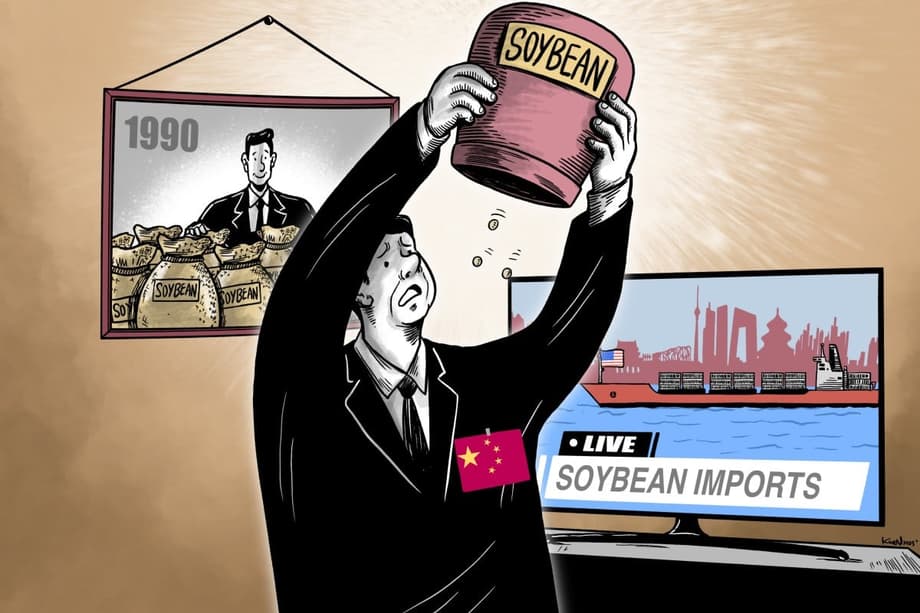Why soybeans define China’s food security strategy now
Soybeans sit at the center of China’s food security calculations and its most fraught trade relationships. The crop is the backbone of animal feed for pigs, poultry, and aquaculture, and it supplies a large share of the country’s cooking oil. That dual role has turned soybeans into a barometer of Beijing’s strategic priorities and a recurring flashpoint in disputes with the United States. China now buys roughly 100 million tons of soybeans each year, about 60 percent of global trade, giving Chinese buyers immense influence over prices, shipping patterns, and farm decisions on multiple continents.
- Why soybeans define China’s food security strategy now
- How China went from exporter to buyer of 100 million tons
- Can China grow its own soybeans at scale
- GM crops, intercropping, and a cautious policy shift
- Trade wars reshape sourcing and pricing
- Diversification reaches Africa and Russia
- Resilience, reserves and price volatility
- Global ripple effects for farmers and the environment
- What it means for consumers and the world market
- The Bottom Line
Beijing’s latest policy signals point to a long game. Draft proposals for the 15th five year plan call for diversified agricultural import sources and better alignment between trade and domestic production. A new food security law requires self sufficiency in staple grains and integrates food security into local economic planning. These steps reflect a simple reality: China cannot meet its protein needs without steady soybean flows, yet it wants to limit exposure to a single supplier or a single route during periods of geopolitical stress and commodity price spikes.
How China went from exporter to buyer of 100 million tons
The shift took three decades. In the 1990s China still exported soybeans. After joining the World Trade Organization in 2001, it liberalized soybean imports and encouraged large coastal crushing plants that turn beans into meal and oil. Rising incomes and a fast growing livestock sector boosted demand for soy meal. Domestic arable land remained prioritized for staple grains like rice, wheat, and corn. Imported soybeans, mostly genetically modified, went into animal feed and cooking oil. Locally grown beans, often preferred as conventional varieties, flowed into tofu, soy milk, and other foods.
From WTO entry to a crushing industry boom
Foreign agribusinesses dominated global soybean trading during the 2000s. Price surges in 2003 to 2004 and again in 2007 to 2008 hammered many Chinese processors, and foreign firms acquired a larger footprint. Inside China, state owned companies took different paths. COFCO and Chinatex partnered with international traders and expanded along global price cycles. Jiusan and Sinograin emphasized stockpiling and policy support for domestic production. The period often called the battle of the beans set the stage for today’s mix of market discipline and national security thinking in China’s oilseed sector.
Can China grow its own soybeans at scale
Beijing wants higher self reliance, yet structural limits are hard to ignore. China must feed close to 20 percent of the world’s population with less than 9 percent of its arable land and roughly 6 percent of freshwater. Soybeans yield less per hectare in China than they do in Brazil or the United States, and the country’s farms are small compared with those in the Americas. These factors make it difficult to scale up domestic soy without sacrificing land needed for staple grains.
The yield gap is wide. China’s average soybean yield is near 1.99 tons per hectare, while Brazil and the United States average around 3.38 and 3.4 tons per hectare. Farm plots in China average about 0.65 hectares, which complicates adoption of modern machinery and raises production costs. The government aims to lift self sufficiency in staple grains and beans to roughly 92 percent by 2033, and internal targets envision a 21 percent drop in soybean imports by that date. The United States Department of Agriculture projects a different trajectory, expecting Chinese soybean imports to grow rather than shrink over the next decade, which underscores how hard it will be to replace foreign beans at scale.
Zheng Fengtian, a professor at Renmin University who has studied Chinese agriculture for more than two decades, captured the trade off in plain terms.
It seems necessary for China to be self reliant on soybeans, but it is impossible to actually achieve this.
GM crops, intercropping, and a cautious policy shift
Beijing is moving to raise yields and upgrade seed technology, but it is proceeding carefully. The Ministry of Agriculture and Rural Affairs recently approved dozens of genetically modified corn and soybean varieties following multi year trials, a first for China at this scale. The goals are straightforward: raise yields, reduce pest losses, and improve stability during supply shocks. Most imported beans are GM and go to feed and oil. Domestic beans used for direct human consumption have largely remained conventional, a pattern that may persist even as GM plantings grow.
Why GM matters for yields
Insect resistant and higher yielding traits can help narrow the gap with Brazil and the United States. Even so, widespread commercialization will take time. Public skepticism, rooted in earlier food safety scandals and distrust of new technologies, has slowed acceptance. Regulators are trying to address those concerns with stricter biosafety reviews and clearer standards. At the same time, agronomists are promoting soybean corn intercropping in northern provinces to squeeze more beans out of existing land. The government is also investing in breeding for saline tolerant and drought tolerant varieties and expanding high quality farmland, but these measures will not unlock millions of tons overnight.
Trade wars reshape sourcing and pricing
Trade friction has repeatedly redirected China’s purchasing. During the 2018 tariff fight, Brazilian shipments surged as US cargoes lost price competitiveness. The pattern has continued in the latest round of tariffs. In 2024, China imported about 105 million tons of soybeans, with roughly 71 percent from Brazil, about 21 percent from the United States, and close to 4 percent from Argentina. New tariffs in 2025 priced many US soybeans out of the market, and Chinese buyers leaned even harder on Brazilian supplies.
Politics has collided with the agricultural calendar. Brazil’s main harvest runs from February to May, with exports peaking from March to August. The US harvest runs from September to November and traditionally covers part of China’s fourth quarter needs. Chinese buyers have increasingly front loaded purchases from Brazil early in the year, then used US cargoes as a flexible option for reserves or quality blends when negotiations allow. Public commitments to buy large volumes from the United States have surfaced at times after high profile meetings, yet buying has often lagged. In one recent window, Chinese purchases totaled only a few hundred thousand tons against multi million ton pledges, showing how diplomacy and commercial timing rarely move in lockstep.
Chinese officials have tried to reassure households and markets that the country’s food supply can withstand tariff swings and supplier changes.
China’s food supply is fully secure, and our reserves are ample. We can adjust sourcing across many partners without affecting domestic stability.
Diversification reaches Africa and Russia
China is spreading its bets. State backed firms and private companies are building relationships beyond the traditional triangle of Brazil, the United States, and Argentina. One example is Angola, where a subsidiary of CITIC announced a 250 million dollar plan to develop up to 100,000 hectares for soybeans and corn. The project aims to use modern mechanization and irrigation, and roughly 60 percent of output is expected to ship to China. Similar frameworks are emerging with other African partners and with Russia, which is seeking more agricultural export outlets to the east.
Africa on the map
Angola has large tracts of arable land underused by regional standards, and potential yields touted by project sponsors far exceed current averages in Sub Saharan Africa. These ventures promise jobs, infrastructure, and technology transfer for host countries, and they give China an additional supply cushion. Even if successful, the new projects will still account for a small fraction of China’s annual needs, which keeps the door open to established suppliers in the Americas. The clear objective is not replacement, it is diversification with an eye on logistics, seasonality, and risk management.
Resilience, reserves and price volatility
Researchers looking at a decade of trade data find that tariff shocks and geopolitical disruptions reduce China’s grain import resilience, a concept that captures how well a system resists shocks, recovers, and adapts to new conditions. During the 2018 US China trade conflict, import prices rose, price volatility increased, volumes dipped, and the breadth of import sources narrowed. The Russia Ukraine war layered on more volatility, even without direct restrictions on Chinese trade. These dynamics pushed Beijing to expand reserves and to coordinate stock releases to blunt price spikes.
Policymakers often describe three capacities that matter for resilience. Resistance is the ability to keep imports flowing during a shock. Recovery is the speed at which flows normalize after disruption. Transformative change is the capacity to diversify suppliers and modernize logistics so that future shocks are less damaging. China is working on all three, from bigger strategic stockpiles and stronger state purchasing to more flexible trade ties with a wider range of partners. Those steps improve stability, yet they do not erase the structural reality that soybeans remain highly traded and exposed to weather, freight costs, and political decisions beyond China’s borders.
Global ripple effects for farmers and the environment
China’s pivot away from US soybeans has reshaped livelihoods across the farm belt. US agricultural exports to China have fallen steeply during tariff escalations, and soybean sales have at times dropped to near zero during key buying windows. Analysts estimate multibillion dollar losses for US farmers in recent years tied to trade barriers and missed harvest season sales, with calls for relief packages returning as pressure builds. Rising costs for fertilizer, machinery, and labor have squeezed margins further, making it harder for small and mid sized farms to absorb shocks. The strategic concern in the United States is that once Chinese buyers deepen relationships with other suppliers, winning back market share can take years.
Brazil has been the biggest beneficiary of China’s reallocation. The country has consistently exceeded past export trends to meet Chinese demand, and farmers have expanded acreage. Environmental groups warn that part of this expansion risks more clearing in sensitive biomes, including parts of the Amazon and Cerrado. Argentina’s exporters, helped by tax changes, have also pushed more beans and soy products to China. Beyond soy, trade friction has reshaped other food flows. Australian beef exports to China increased after Chinese regulators let US beef licenses lapse, while canola trade has become a moving target, with China reducing reliance on Canada and exploring more purchases from Australia when politics and plant disease rules allow. The environmental and economic costs of these shifts are large and uneven, and they ripple through freight, fertilizer, and land use markets worldwide.
What it means for consumers and the world market
For Chinese households, the soybean story shows up in bottles of cooking oil and in prices for pork, poultry, and farmed fish. When soybean meal gets more expensive, feed costs rise and meat becomes more costly to produce. China’s large reserves, diversified sourcing, and state guided purchasing have kept domestic price swings contained during most shocks. Still, logistics bottlenecks, droughts in exporting countries, or sudden policy shifts can lift costs, and those pressures filter into food prices that are closely watched by the public.
For the global market, China’s weight is unmatched. When the country buys earlier or later than usual, prices move. When tariff levels change, the entire flowchart of beans across the oceans is redrawn. Brazil’s currency, US Gulf and Pacific Northwest export margins, and freight rates on key shipping routes all feel the effects. Looking ahead, China is likely to raise domestic soybean output with better seeds and intercropping and to keep improving reserves. It will still rely on imports for the bulk of its needs. The sourcing map will keep widening across Brazil, Argentina, the United States during seasonal windows, and newer suppliers in Africa and Russia. The goal is a stable, flexible supply chain that protects domestic food security while avoiding overreliance on any single partner, even as trade politics remain volatile.
The Bottom Line
- China buys around 100 million tons of soybeans a year, close to 60 percent of global trade.
- Import dependence grew after WTO entry as crushing capacity expanded and meat consumption climbed.
- Domestic expansion faces limits from land, water, small farm size, and a wide yield gap with Brazil and the United States.
- Beijing approved new GM soybean and corn varieties, yet widespread commercialization will roll out gradually.
- Policy aims to diversify import sources and align trade with domestic production while keeping staple grains self sufficient.
- Brazil is the main supplier, the US share has fallen during tariff flare ups, though seasonal needs can keep some US cargoes in play.
- Investments in Angola and partnerships with other countries show a push to add new supply options outside the Americas.
- Trade shocks reduce import resilience and increase price volatility, which China counters with larger reserves and flexible sourcing.
- US farmers and South American ecosystems are feeling the effects of China’s pivot, with economic losses and land use pressure.
- China will remain import dependent for soybeans, even as it boosts domestic output and uses reserves, technology, and diversification to manage risk.












